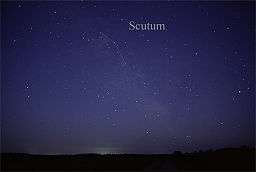Scutum
| Constellation | |
|
| |
| Abbreviation | Sct |
|---|---|
| Genitive | Scuti |
| Pronunciation |
/ˈskjuːtəm/, genitive /ˈskjuːtaɪ/ |
| Symbolism | the Shield |
| Right ascension | 18.7 |
| Declination | −10 |
| Family | Hercules |
| Quadrant | SQ4 |
| Area | 109 sq. deg. (84th) |
| Main stars | 2 |
| Bayer/Flamsteed stars | 7 |
| Stars with planets | 1 |
| Stars brighter than 3.00m | 0 |
| Stars within 10.00 pc (32.62 ly) | 0 |
| Brightest star | α Scuti (3.85m) |
| Nearest star |
LHS 3398 (41.54 ly, 12.74 pc) |
| Messier objects | 2 |
| Meteor showers | June Scutids |
| Bordering constellations |
Aquila Sagittarius Serpens Cauda |
|
Visible at latitudes between +80° and −90°. Best visible at 21:00 (9 p.m.) during the month of August. | |
Scutum is a small constellation introduced in the seventeenth century. Its name is Latin for shield.
History


Scutum was named in 1684 by Polish astronomer Johannes Hevelius[1] (Jan Heweliusz), who originally named it Scutum Sobiescianum (Shield of Sobieski) to commemorate the victory of the Christian forces led by Polish King John III Sobieski (Jan III Sobieski) in the Battle of Vienna in 1683. Later, the name was shortened to Scutum.
Five bright stars of Scutum (α Sct, β Sct, δ Sct, ε Sct and η Sct) were previously known as 1, 6, 2, 3, and 9 Aquilae respectively.[2]
Coincidentally, the Chinese also associated these stars with battle armor, incorporating them into the larger asterism known as Tien Pien, i.e., the Heavenly Casque (or Helmet).[3]
Notable features
Stars
Scutum is not a bright constellation, with the brightest star, Alpha Scuti, at magnitude 3.85. But some stars are notable in the constellation. Beta Scuti is the second brightest at magnitude 4.22, followed by Delta Scuti at magnitude 4.72. Beta Scuti is a binary system, with the primary with a spectral type similar to the Sun, although it is 1,270 times brighter. Delta Scuti is a bluish white giant star, which is now coming at the direction of the Solar System. Within 1.3 million years it will come as close to 10 light years from Earth, and will be much brighter than Sirius by that time.
Scutum is also notable for having UY Scuti, a red supergiant pulsating variable star. At 1,708 ± 192 solar radii, it is one of the largest stars currently known.
Deep sky objects
Although not a large constellation, Scutum contains several open clusters, as well as a globular cluster and a planetary nebula. The two best known deep sky objects in Scutum are M11 (the Wild Duck Cluster) and the open cluster M26 (NGC 6694). The globular cluster NGC 6712 and the planetary nebula IC 1295 can be found in the eastern part of the constellation, only 24 arcminutes apart.
The most prominent open cluster in Scutum is the Wild Duck Cluster, M11. It was named by William Henry Smyth in 1844 for its resemblance in the eyepiece to a flock of ducks in flight. The cluster, 6200 light-years from Earth and 20 light-years in diameter, contains approximately 3000 stars, making it a particularly rich cluster. It is 220 million years old.[4]
Space exploration
The Space probe Pioneer 11 is moving in the direction of this constellation, though it will not be nearing any of the stars in this constellation for many thousands of years, by which time its batteries will be long dead.
See also
- Taurus Poniatovii - a constellation created by the Polish astronomer Marcin Odlanicki Poczobutt in 1777 to honor King of Poland Stanislaus Augustus Poniatowski.

References
- ↑ Star Tales ― Scutum by Ian Ridpath
- ↑ Wagman, M. (August 1987). "Flamsteed's Missing Stars". Journal for the History of Astronomy 18 (3): 212–213. Bibcode:1987JHA....18..209W.
- ↑ Richard H. Allen (1899) Star Names and Their Meanings, p. 363
- ↑ MacRobert, Alan (September 2012). "So, Where Are the Wild Ducks?!". Sky and Telescope.
- Ian Ridpath and Wil Tirion (2007). Stars and Planets Guide, Collins, London. ISBN 978-0-00-725120-9. Princeton University Press, Princeton. ISBN 978-0-691-13556-4.
External links
| Wikimedia Commons has media related to Scutum. |
- The Deep Photographic Guide to the Constellations: Scutum
- Star Tales – Scutum
- Scutum Constellation at Constellation Guide
| ||||||||||||||||||||||||||
| ||||||||||||||||||||||||||||||||||||||||
Coordinates: ![]() 18h 42m 00s, −10° 00′ 00″
18h 42m 00s, −10° 00′ 00″
